Incorporating Problem-Posing into Sixth-Grade Mathematics Classes
Abstract
:1. Introduction
2. Theoretical Background
2.1. Problem-Posing
2.2. The Active Learning Framework for Problem-Posing
2.3. Problem-Posing and Problem-Solving
2.4. A Framework for Interpreting the Problem-Posing Process and Product
3. The ALF Research Project
3.1. Subjects
3.2. The Impact of the COVID-19 Pandemic on the Experiment
3.3. Task Organization
4. Data Collection and Analysis
- Example 1 (School 1, Topic 1, proportional division, lesson 2).
- Model problem (M2). Rita and Eva bought 18 dragon fruits. Rita gave € 8, and Eve € 28 for the fruit. How many dragon fruits did a girl get if the fruit was distributed in proportion to the money paid?
- Problem-posing assignment with problem solving (PP2 + PS2). Create a word problem for proportional division. Additionally, write the text of the task and the detailed solution.
5. Results and Discussion
5.1. The Problem-Posing Performance
- (1)
- The two schools perform differently. The percentage of competent tasks is 84% in School 1 and 71% in School 2. The difference between the two schools is significant, according to Fisher’s exact test at the level; see contingency Table A3 of Appendix B.
- (2)
- Students from School 2 are less successful in the second teaching unit (i.e., in PP4 and PP5) than in the first (i.e., in PP1 and PP2). Moreover, the difference is significant with ; see contingency Table A4 in Appendix B.
- (3)
- Students from School 1 are less successful in PP5 than in the other tasks, and the difference is significant with ; see contingency Table A5 in Appendix B.
- Example. (School 1, PP5. The lesson topic is direct and inverse proportionality).
- Previously, the model problem required students to classify the connection between two variable quantities as direct proportionality, inverse proportionality, or neither. For the nonproportional relationship, the following model problem was provided:
- Model problem. A 5-year-old boy weighs 18 kg. How many kg will he weigh at the age of 65?
- Assignment. Create a word problem. There should be no proportionality in this task. Provide a solution to this problem as well.
- Example. (School 1, Topic 1, proportional division, lesson 1).
- Problem-posing assignment with problem solving (PP1 + PS1). Laci and Robi received a large box of jam Linzer cookies from their grandmother. All 60 Linzers should be distributed between the two boys to ensure they do not receive the same number of cookies. Guess on what basis and in what ratio they should distribute the cookies. How many cookies did each of the boys receive? Write a word problem, and describe a detailed solution as well.
- decomposes 60 by the sum of two numbers: ;
- simplifies the fraction: ;
- checks who obtains 24 and 36 pieces if dividing the Linzers in the ratio of :
- sets the task: Laci and Robi got 60 Linzers from their grandmother. It should be divided 2:3 so that Laci gets less because he is on a diet.
5.2. Problem-Solving Performance and its Relationship with the Quality of Problem-Posing
- Example. (School 2, Topic 1, adding and subtracting fractions, lesson 1).
- Model problem (M1). Kati and Laci are sixth graders, and they start their school day. In their math class, they need to solve a number pyramid. Help them: add up two adjacent numbers and write the result in the cell above them. Continue until the pyramid is complete. Tip: You can also use the reverse operation of addition.
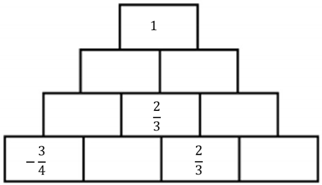
- The problem-posing assignment with problem solving (PP1 + PS1). Make a new pyramid for Kati and Laci with the following three numbers: . Your task is to draw a pyramid in your notebook with three levels and put the given numbers in it. Write the given numbers in red and the calculated numbers in blue. After solving the first pyramid, draw another pyramid, put the given number into it differently, and solve the pyramid again.
6. Conclusions
7. Limitations
Author Contributions
Funding
Institutional Review Board Statement
Informed Consent Statement
Data Availability Statement
Conflicts of Interest
Appendix A
- The Topics of Experimental Lessons in School 1
- Topic 1. Proportional Division, Lesson 1
- Model Problem (M1)
- Practice Exercise (P1)
- Problem-Posing Assignment with Problem-Solving (PP1 + PS1)
- Topic 1. Proportional Division, Lesson 2
- Model Problem (M2)
- Practice Exercises (P2)
- (a)
- The difference between two numbers is 18, and their ratio is 3:5. Which are these?
- (b)
- Two numbers add up to 108, and the ratio is 4:5. What are these two numbers?
- (c)
- A family planned a three-day, 90-km bicycle tour to the Mátra Mountains, with a 5:6:4 daily distance ratio. How many kilometers were traveled each day?
- Problem-Posing Assignment with Problem-Solving (PP2 + PS2)
- Classmate’s Problem (PS3)
- Topic 2. Direct and Inverse Proportionality, Lesson 4
- Model Problem (M4)
- Practice Exercises (P4)
- The strudels cost 150 HUF each. How many forints do seven strudels cost?
- A 5-year-old boy weighs 18 kg. How many kilograms will he weigh at 65?
- If six cows graze in the field, there is enough grass for ten days. How many days will the grass last if only two cows graze and grass growth is ignored?
- Problem-Posing Assignment with Problem-Solving (PP4 + PS4)
- Topic 2. Direct and Inverse Proportionality, Lesson 5
- Model Problem (M5)
| Velocity (km/h) | 2 | 3 | 5 | 6 | 10 | 14 | 15 | 30 | 60 |
| Time (h) |
- Practice Exercises (P5)
- (a)
- A piece of land requires 46 days of labor for 15 trucks. How long will it take 23 identically-powered trucks to complete the same task?
- (b)
- If 640 kg of coal is used daily, there is enough coal to heat a hospital for 45 days. However, 720 kg of coal daily is consumed due to the extreme cold. How long will the hospital’s stock last?
- Problem-Posing Assignment with Problem-Solving (PP5 + PS5)
- Classmate’s Problem (PS6)
- The Topic of Experimental Lessons in School 2
- Topic 1. Adding and Subtracting Rational Numbers, Lesson1
- Model Problem (M1)

- Practice Exercise (P1)
- Problem-Posing Assignment with Problem-Solving (PP1 + PS1)
- Topic 1. Adding and Subtracting Rational Numbers, Lesson2
- Model Problem (M2)
- How many kg has Kati bought?
- How many kg has Laci bought?
- Who bought more, and by how much?
- Practice Exercise (P2)
- Problem-Posing Assignment with Problem-Solving (PP2 + PS2)
- Classmate’s Problem (PS3)
- (a)
- Kati and Laci went shopping. Kati has Ron and Laci has 2.27 Ron. They want to buy a toy that costs Ron. How much money do they have together? Are they able to buy the toy? If they could buy the toy, how much money would be left? If they could not buy the toy, how much money would they miss?
- (b)
- Kati and Laci went to school. Laci walked km and Kati walked 2,27 km. The school is km away from their home. Who is closer to the school? How much do they need to walk separately?
- Topic 2. Multiplying and Dividing Rational Numbers, Lesson 4
- Model Problem (M4)
| E | E | R |
| Z | L | K |
| S | R | T |
- Practice Exercise (P4)
- Problem-Posing Assignment with Problem-Solving (PP4 + PS4)
- Topic 2. Multiplying and Dividing Rational Numbers, Lesson 5
- Model Problem (M5)
- Practice Exercises (P5)
- Problem-Posing Assignment with Problem-Solving (PP5 + PS5)
- Classmate’s Problem (PS6)
- (a)
- Piroska is doing the dishes. She needs to wash 7 plates, 3 glasses, 5 spoons, 4 forks, and 2 knives. How much time does she spend doing the dishes if she needs 2 min to wash 1 plate, 1.5 min to wash a glass, 0.9 min to wash a spoon, and 0.6 min to wash a knife?
- (b)
- Piroska and her grandma collect mallow from the garden. They enjoyed the activity, so they spent 3.5 h collecting the herb. They collected kg in one hour. How many kg did they collect in 3.5 h?
Appendix B
| Competent | Incompetent | Sum | |
|---|---|---|---|
| School 1 | 148 | 28 | 176 |
| School 2 | 119 | 49 | 168 |
| Sum | 267 | 77 | 344 |
| Competent | Incompetent | Sum | |
|---|---|---|---|
| PP1 and PP2 | 72 | 12 | 84 |
| PP4 and PP5 | 47 | 37 | 84 |
| Sum | 119 | 49 | 168 |
| Competent | Incompetent | Sum | |
|---|---|---|---|
| PP1, PP2 and PP4 | 116 | 16 | 132 |
| PP5 | 32 | 12 | 44 |
| Sum | 148 | 28 | 176 |
References
- English, L.D. The development of fifth-grade children’s problem-posing abilities. Educ. Stud. Math. 1997, 34, 183–217. [Google Scholar] [CrossRef]
- Cai, J.; Hwang, S.; Jiang, C.; Silber, S. Problem-Posing Research in Mathematics Education: Some Answered and Unanswered Questions. In Mathematical Problem Posing; Singer, F.M., Ellerton, N.F., Cai, J., Eds.; Springer: New York, NY, USA, 2015; pp. 3–34. [Google Scholar] [CrossRef]
- Ellerton, N.F. Engaging pre-service middle-school teacher-education students in mathematical problem posing: Development of an active learning framework. Educ. Stud. Math. 2013, 83, 87–101. [Google Scholar] [CrossRef]
- Xie, J.; Masingila, J.O. Examining Interactions between Problem Posing and Problem Solving with Prospective Primary Teachers: A Case of Using Fractions. Educ. Stud. Math. 2017, 96, 101–118. [Google Scholar] [CrossRef]
- Erkan, B.; Kar, T. Pre-service mathematics teachers’ problem-formulation processes: Development of the revised active learning framework. J. Math. Behav. 2022, 65, 100918. [Google Scholar] [CrossRef]
- Kontorovich, I.; Koichu, B.; Leikin, R.; Berman, A. An exploratory framework for handling the complexity of mathematical problem posing in small groups. J. Math. Behav. 2012, 31, 149–161. [Google Scholar] [CrossRef]
- Pehkonen, E. Introduction to the concept “open-ended problem.” In Use of Open-Ended Problems in Mathematics Classroom; Pehkonen, E., Ed.; Department of Teacher Education, University of Helsinki: Helsinki, Finland, 1997; pp. 7–11. [Google Scholar]
- Silver, E.A. On Mathematical Problem Posing. Learn. Math. 1994, 14, 19–28. [Google Scholar]
- Koichu, B. Problem posing in the context of teaching for advanced problem solving. Int. J. Educ. Res. 2020, 102, 101428. [Google Scholar] [CrossRef]
- English, L.D. Teaching and learning through mathematical problem posing: Commentary. Int. J. Educ. Res. 2020, 102, 101451. [Google Scholar] [CrossRef]
- Baumanns, L.; Rott, B. Rethinking Problem-Posing Situations: A Review. Investig. Math. Learn. 2021, 13, 59–76. [Google Scholar] [CrossRef]
- Papadopoulos, I.; Patsiala, N.; Baumanns, L.; Rott, B. Multiple Approaches to Problem Posing: Theoretical Considerations Regarding its Definition, Conceptualisation, and Implementation. Cent. Educ. Policy Stud. J. 2021, 12, 13–34. [Google Scholar] [CrossRef]
- Cai, J.; Hwang, S. Learning to teach through mathematical problem posing: Theoretical considerations, methodology, and directions for future research. Int. J. Educ. Res. 2020, 102, 101391. [Google Scholar] [CrossRef]
- Kilpatrick, J. Problem formulating: Where do good problems come from? In Cognitive Science and Mathematics Education; Schoenfeld, A.H., Ed.; Routledge: New York, NY, USA, 1987; pp. 123–147. [Google Scholar] [CrossRef]
- Osana, H.P.; Pelczer, I. A Review on Problem Posing in Teacher Education. In Mathematical Problem Posing; Singer, F.M., Ellerton, N.F., Cai, J., Eds.; Springer: New York, NY, USA, 2015; pp. 469–492. [Google Scholar] [CrossRef]
- Crespo, S. Learning to pose mathematical problems: Exploring changes in preservice teachers’ practices. Educ. Stud. Math. 2003, 52, 243–270. [Google Scholar] [CrossRef]
- Tabach, M.; Friedlander, A. Problem Posing as a Learnable Activity. Didact. Math. 2015, 37, 93–110. [Google Scholar] [CrossRef]
- Örnek, T.; Soylu, Y. A model design to be used in teaching problem posing to develop problem-posing skills. Think. Ski. Creat. 2021, 41, 100905. [Google Scholar] [CrossRef]
- Cai, J.; Brook, M. Looking Back in Problem Solving. Math. Teach. Inc. Micromath 2006, 196, 42–45. [Google Scholar]
- Polya, G. How to Solve It: A New Aspect of Mathematical Method, 1st ed.; Princeton University Press: Princeton, NJ, USA, 1945. [Google Scholar]
- Ellerton, N.F. Children’s made-up mathematics problems? A new perspective on talented mathematicians. Educ. Stud. Math. 1986, 17, 261–271. [Google Scholar] [CrossRef]
- Cai, J.; Hwang, S. A perspective for examining the link between problem posing and problem solving. In Proceedings of the 2003 Joint Meeting of PME and PMENA, Honolulu, HI, USA, 13–18 July 2003; Pateman, N.A., Dougherty, B.J., Zilliox, J.T., Eds.; College of Education, University of Hawaii: Honolulu, HI, USA, 2003; Volume 1–3, pp. 103–110. [Google Scholar]
- Xu, B.; Cai, J.; Liu, Q.; Hwang, S. Teachers’ predictions of students’ mathematical thinking related to problem posing. Int. J. Educ. Res. 2020, 102, 101427. [Google Scholar] [CrossRef]
- Zhang, L.; Cai, J.; Song, N.; Zhang, H.; Chen, T.; Zhang, Z.; Guo, F. Mathematical problem posing of elementary school students: The impact of task format and its relationship to problem solving. ZDM Math. Educ. 2022, 54, 497–512. [Google Scholar] [CrossRef]
- Cai, J.; Hwang, S. Generalized and generative thinking in US and Chinese students’ mathematical problem solving and problem posing. J. Math. Behavior 2002, 21, 401–421. [Google Scholar] [CrossRef]
- Schoenfeld, A.H. Mathematical Problem Solving; Academic Press: San Diego, CA, USA, 1985. [Google Scholar]
- Lavy, I.; Bershadsky, I. Problem posing via “what if not?” strategy in solid geometry—A case study. J. Math. Behav. 2003, 22, 369–387. [Google Scholar] [CrossRef]
- Brown, S.I.; Walter, M.I. The Art of Problem Posing, 2nd ed.; Routledge: New York, NJ, USA, 2012. [Google Scholar]
- OECD; Eurostat; UNESCO Institute for Statistics. ISCED 2011 Operational Manual: Guidelines for Classifying National Education Programmes and Related Qualifications; OECD: Paris, France, 2011. [Google Scholar] [CrossRef]
- Feldman, A. Validity and quality in action research. Educ. Action Res. 2007, 15, 21–32. [Google Scholar] [CrossRef]
- Feldman, A.; Altrichter, H.; Posch, P.; Somekh, B. Teachers Investigate Their Work: An Introduction to Action Research across the Professions, 3rd ed.; Routledge: London, UK, 2018. [Google Scholar] [CrossRef]
- Sprent, P. Fisher Exact Test. In International Encyclopedia of Statistical Science, Lovric, M., Ed.; Springer: Berlin/Heidelberg, Germany, 2011; pp. 524–525. [Google Scholar] [CrossRef]
- Báró, E. Positive changes in affective variables: Two-round action research in Hungary and Romania. In Proceedings of the Twelfth Congress of the European Society for Research in Mathematics Education (CERME12), Bozen-Bolzano, Italy, 2–5 February 2022. [Google Scholar]
- Cohen, J. A Coefficient of Agreement for Nominal Scales. Educ. Psychol. Meas. 1960, 20, 37–46. [Google Scholar] [CrossRef]
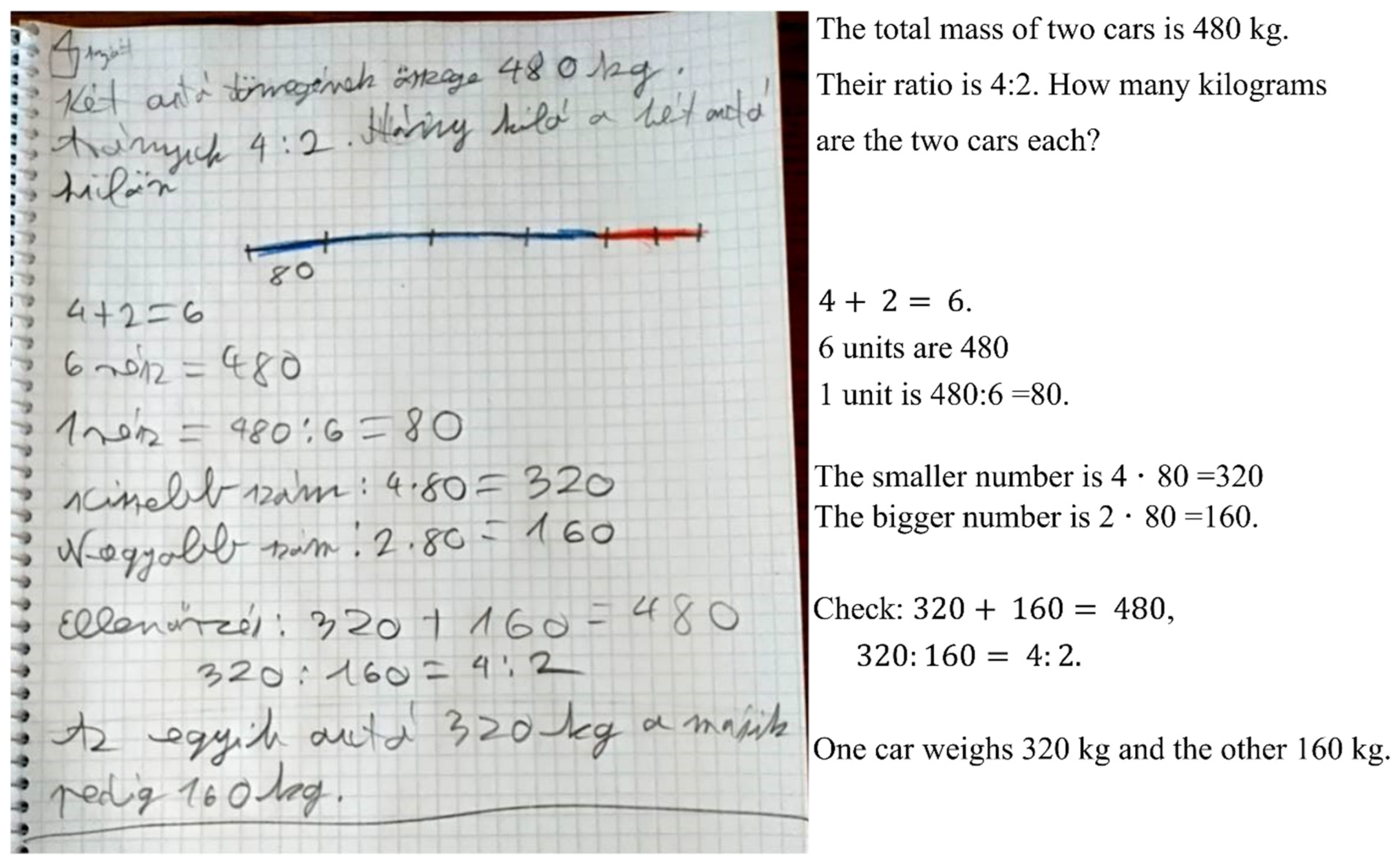
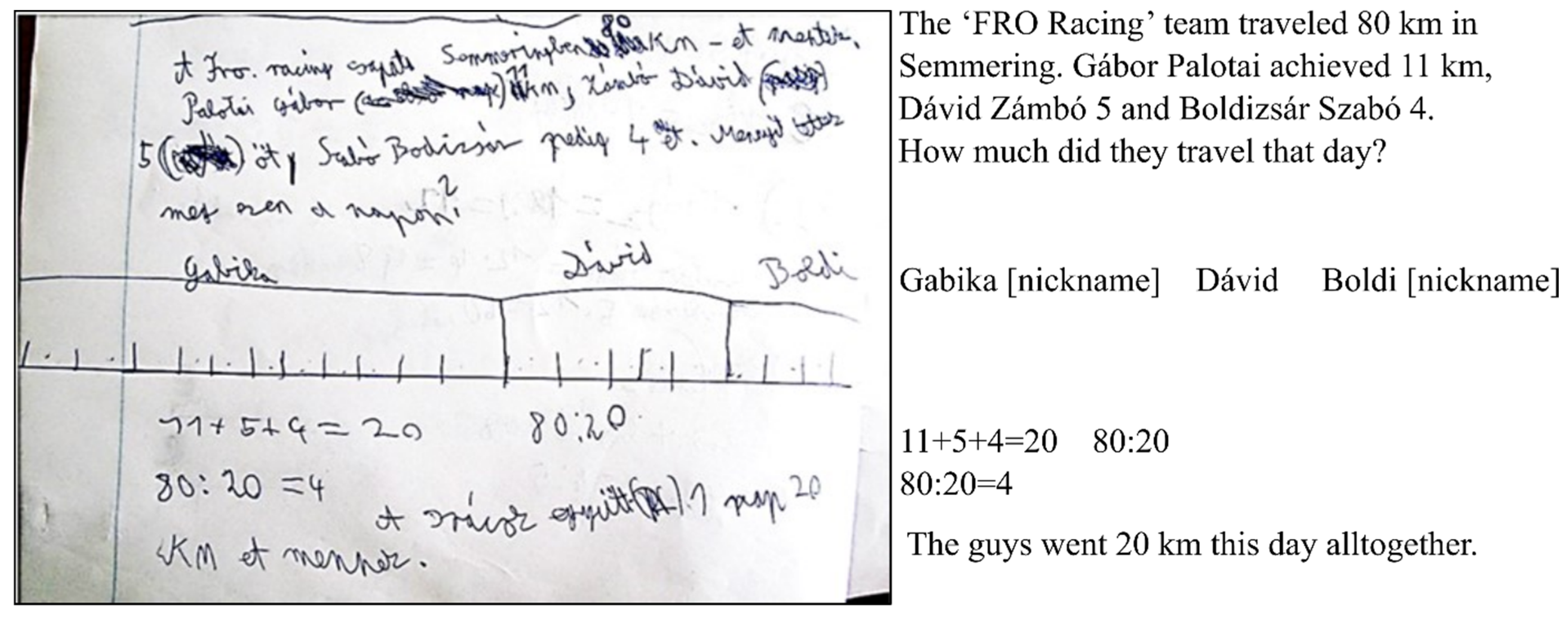
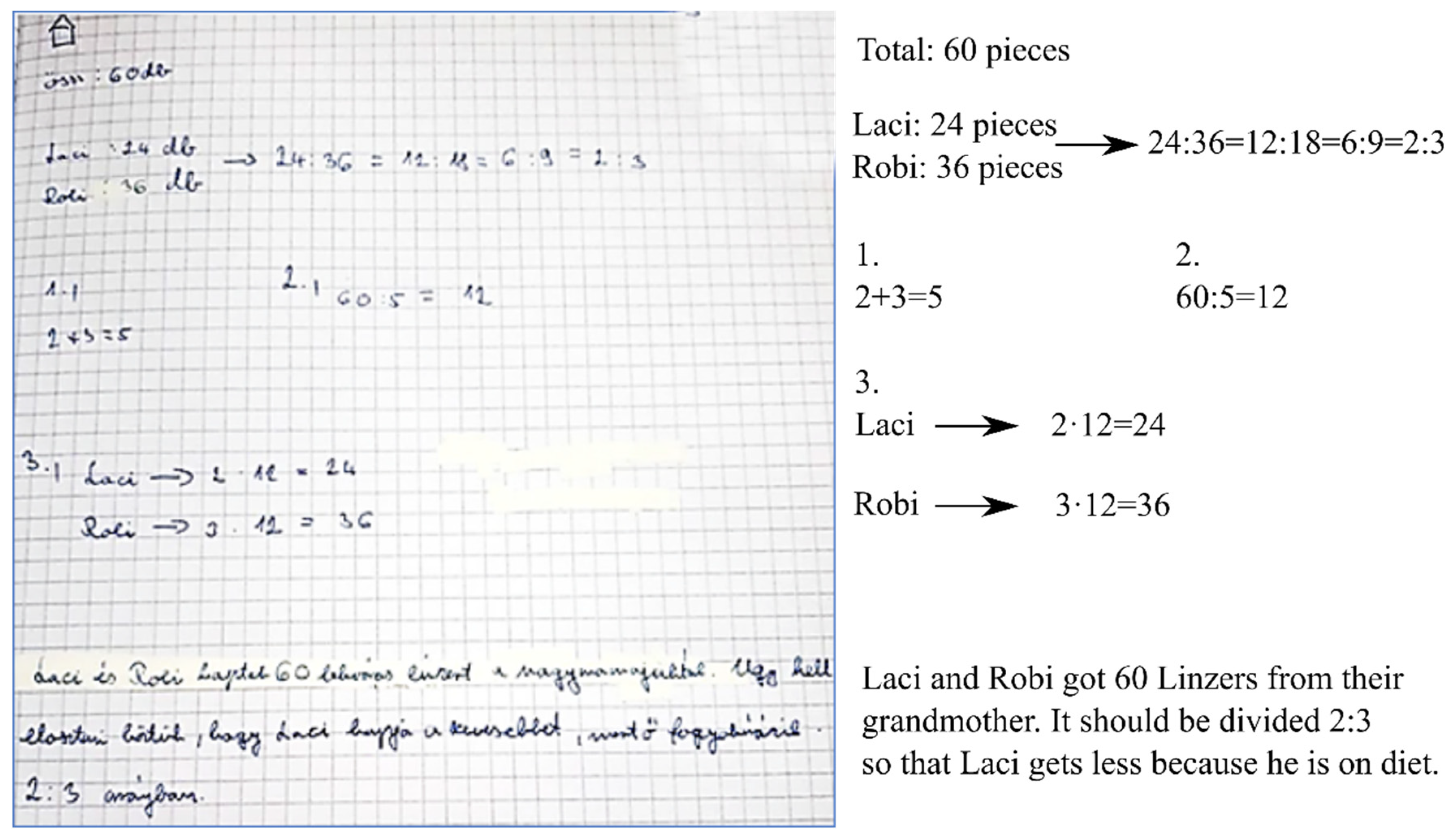
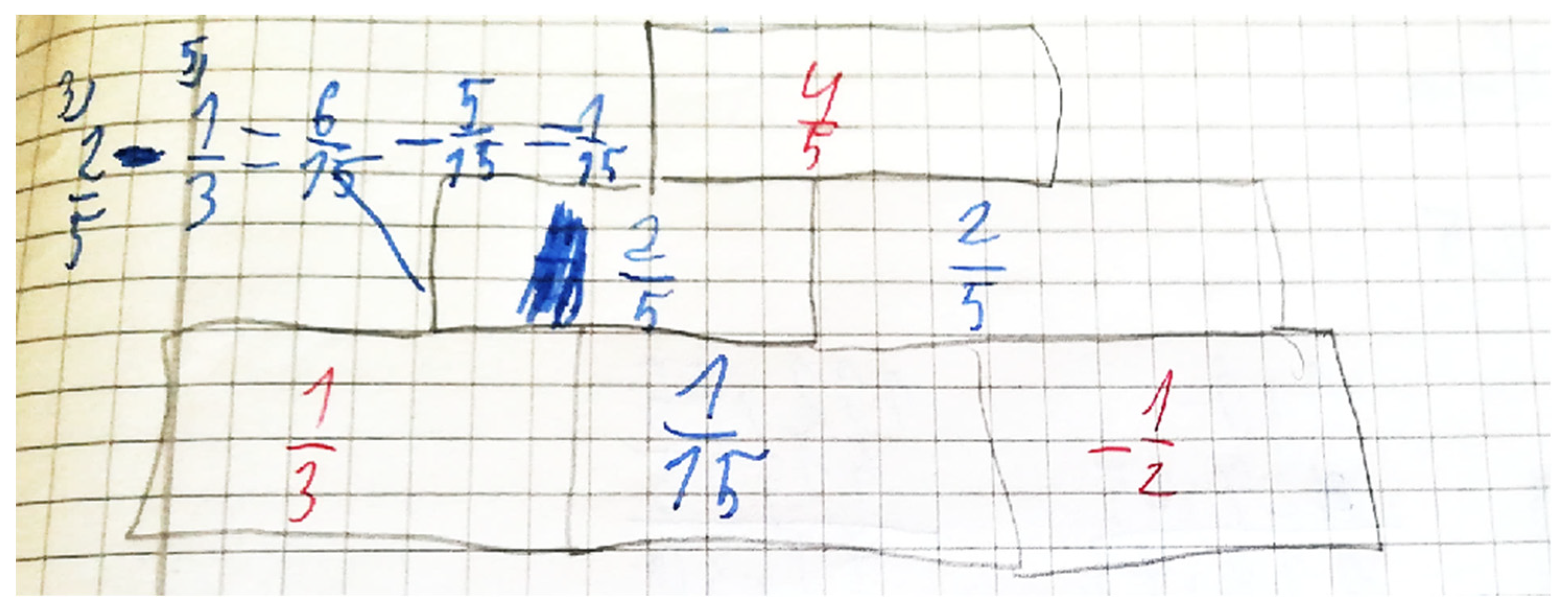
| Model | Practice | Problem-Posing | Problem-Solving |
|---|---|---|---|
| Processing the new content, the teacher models examples and draws attention to the textbook | Students locate examples and solve problems based on the model | Students pose problems with the same structure as the model | The class discusses and solves problems posed by students |
| Romanian grades | 1, 2, 3, 4 | 5 | 6, 7 | 8 | 9, 10 |
| Hungarian grades | 1 | 2 | 3 | 4 | 5 |
| The Number of Students | The Number of the Students Who Received a 4 or 5 | The Number of the Students Who Received a 2 or 3 | |
|---|---|---|---|
| School 1 | 44 | 43 | 1 |
| School 2 | 42 | 29 | 13 |
| Sum | 86 | 72 | 14 |
| Lesson | Activity | The Topic of the Teaching Unit in School 1 | The Topic of the Teaching Unit in School 2 |
|---|---|---|---|
| 1. | M, P, PP + PS | Proportional division | Addition and subtraction of fractions |
| 2. | M, P, PP + PS | ||
| 3. | PS | ||
| 4. | M, P, PP + PS | Direct and inverse proportionality | Multiplication and division of fractions |
| 5. | M, P, PP + PS | ||
| 6. | PS |
| Main Dimension | Corpus Includes | Codes | Definition |
|---|---|---|---|
| Quality of problem posing | Problem-posing tasks | Competent (C) | The student submitted their work following the teacher’s instructions. The student understood the model problem; the mathematical background is appropriate. Decision rule: If the student provided redundant but not contradictory data, their work is still classified in this category. |
| Incompetent (IC) | The student submitted an uninterpretable task or a meaningful math task, but not as instructed by the teacher. Decision rule: If the student included contradictory data, their work is classified as incompetent. | ||
| Quality of problem solving | The solution to the student’s “competent” tasks and classmates’ tasks | Correct solution (CT) | The student solved the problem correctly. This category also includes work where the student applied the mathematical model correctly but made a calculation or scaling error. |
| False solution (F) | The learner misapplied the new material. | ||
| No solution | The student did not submit a solution. |
| Dimension | Code | Explanation |
|---|---|---|
| Quality of problem posing | C | The task corresponds to the mathematical description. |
| Quality of problem solving | CT | The solution is correct. |
| Dimension | Code | Explanation |
|---|---|---|
| Quality of problem posing | IC | The task does not correspond to the requirement. Moreover, it contains contradictory data: . The student probably wanted to split the 80 km distance in the ratio of . The student drew accordingly; the division in his work also indicates this. However, the student’s question is not about proportional division. |
| Quality of problem solving | - | The student answered his question correctly . The coder does not code the solution because the problem posing was assigned the “incompetent” code. |
| Cohen’s Kappa | |
|---|---|
| Quality of problem posing | 0.89 |
| Quality of problem solving | 0.88 |
| Competent (C) | Incompetent (IC) | Sum (N) | C/N | |
|---|---|---|---|---|
| PP1 | 38 | 6 | 44 | 0.86 |
| PP2 | 37 | 7 | 44 | 0.84 |
| PP4 | 41 | 3 | 44 | 0.93 |
| PP5 | 32 | 12 | 44 | 0.73 |
| Sum | 148 | 28 | 176 | 0.84 |
| Competent (C) | Incompetent (IC) | Sum (N) | C/N | |
|---|---|---|---|---|
| PP1 | 37 | 5 | 42 | 0.88 |
| PP2 | 35 | 7 | 42 | 0.83 |
| PP4 | 25 | 17 | 42 | 0.60 |
| PP5 | 22 | 20 | 42 | 0.52 |
| Sum | 119 | 49 | 168 | 0.71 |
| Competent (C) | Incompetent (IC) | Sum (N) | C/N | |
|---|---|---|---|---|
| PP1 | 29 | 0 | 29 | 1.00 |
| PP2 | 26 | 3 | 29 | 0.90 |
| PP4 | 19 | 10 | 29 | 0.65 |
| PP5 | 20 | 9 | 29 | 0.69 |
| Sum | 94 | 22 | 116 | 0.81 |
| Competent (C) | Incompetent (IC) | Sum (N) | C/N | |
|---|---|---|---|---|
| High achievers | 94 | 22 | 116 | 0.81 |
| Low achievers | 25 | 27 | 52 | 0.48 |
| Sum | 119 | 49 | 168 | 0.71 |
| Task | CT | F | No Solution | N | CT/N |
|---|---|---|---|---|---|
| PS1 | 35 | 3 | 0 | 38 | 0.92 |
| PS2 | 35 | 2 | 0 | 37 | 0.95 |
| PS3 (*) | 33 | 8 | 3 | 44 | 0.75 |
| PS4 | 40 | 0 | 1 | 41 | 0.98 |
| PS5 | 31 | 1 | 0 | 32 | 0.97 |
| PS6 (*) | 36 | 4 | 4 | 44 | 0.81 |
| Sum | 210 | 18 | 8 | 236 | 0.89 |
| Task | CT | F | No solution | N | CT/N |
|---|---|---|---|---|---|
| PS1 | 29 | 8 | 0 | 37 | 0.78 |
| PS2 | 34 | 0 | 1 | 35 | 0.97 |
| PS3 (*) | 34 | 6 | 2 | 42 | 0.81 |
| PS4 | 19 | 5 | 1 | 25 | 0.76 |
| PS5 | 21 | 1 | 0 | 22 | 0.95 |
| PS6 (*) | 32 | 7 | 3 | 42 | 0.76 |
| Sum | 169 | 27 | 7 | 203 | 0.83 |
| Correct Solution (CT) | False Solution (F) | Sum | |
|---|---|---|---|
| Solving own problem | 141 | 6 | 147 |
| Solving classmate’s problem | 69 | 12 | 81 |
| Sum | 210 | 18 | 228 |
| Correct Solution (CT) | False Solution (F) | Sum | |
|---|---|---|---|
| Only numerical information (PS1, PS4) | 48 | 13 | 61 |
| Numerical information placed in context (PS2, PS5, PS3, PS6) | 121 | 14 | 135 |
| Sum | 169 | 27 | 196 |
| Median for | Median for | |
|---|---|---|
| School 1 | 0.75 | 0.83 |
| School 2 (all students) | 0.75 | 0.67 |
| School 2 (high achievers) | 0.75 | 0.83 |
| School 2 (low achievers) | 0.50 | 0.50 |
| Sum | |||
|---|---|---|---|
| 3 | 11 | 14 | |
| 0 | 30 | 30 | |
| Sum | 3 | 41 | 44 |
| Sum | |||
|---|---|---|---|
| 13 | 3 | 16 | |
| 2 | 24 | 26 | |
| Sum | 15 | 27 | 42 |
| Sum | |||
|---|---|---|---|
| 6 | 4 | 10 | |
| 0 | 19 | 19 | |
| Sum | 6 | 23 | 29 |
Disclaimer/Publisher’s Note: The statements, opinions and data contained in all publications are solely those of the individual author(s) and contributor(s) and not of MDPI and/or the editor(s). MDPI and/or the editor(s) disclaim responsibility for any injury to people or property resulting from any ideas, methods, instructions or products referred to in the content. |
© 2023 by the authors. Licensee MDPI, Basel, Switzerland. This article is an open access article distributed under the terms and conditions of the Creative Commons Attribution (CC BY) license (https://creativecommons.org/licenses/by/4.0/).
Share and Cite
Kovács, Z.; Báró, E.; Lócska, O.; Kónya, E. Incorporating Problem-Posing into Sixth-Grade Mathematics Classes. Educ. Sci. 2023, 13, 151. https://doi.org/10.3390/educsci13020151
Kovács Z, Báró E, Lócska O, Kónya E. Incorporating Problem-Posing into Sixth-Grade Mathematics Classes. Education Sciences. 2023; 13(2):151. https://doi.org/10.3390/educsci13020151
Chicago/Turabian StyleKovács, Zoltán, Emőke Báró, Orsolya Lócska, and Eszter Kónya. 2023. "Incorporating Problem-Posing into Sixth-Grade Mathematics Classes" Education Sciences 13, no. 2: 151. https://doi.org/10.3390/educsci13020151
APA StyleKovács, Z., Báró, E., Lócska, O., & Kónya, E. (2023). Incorporating Problem-Posing into Sixth-Grade Mathematics Classes. Education Sciences, 13(2), 151. https://doi.org/10.3390/educsci13020151





